Why Online Shoppers Drop Off (and How Conversational AI Agents Can Drive More Conversions)
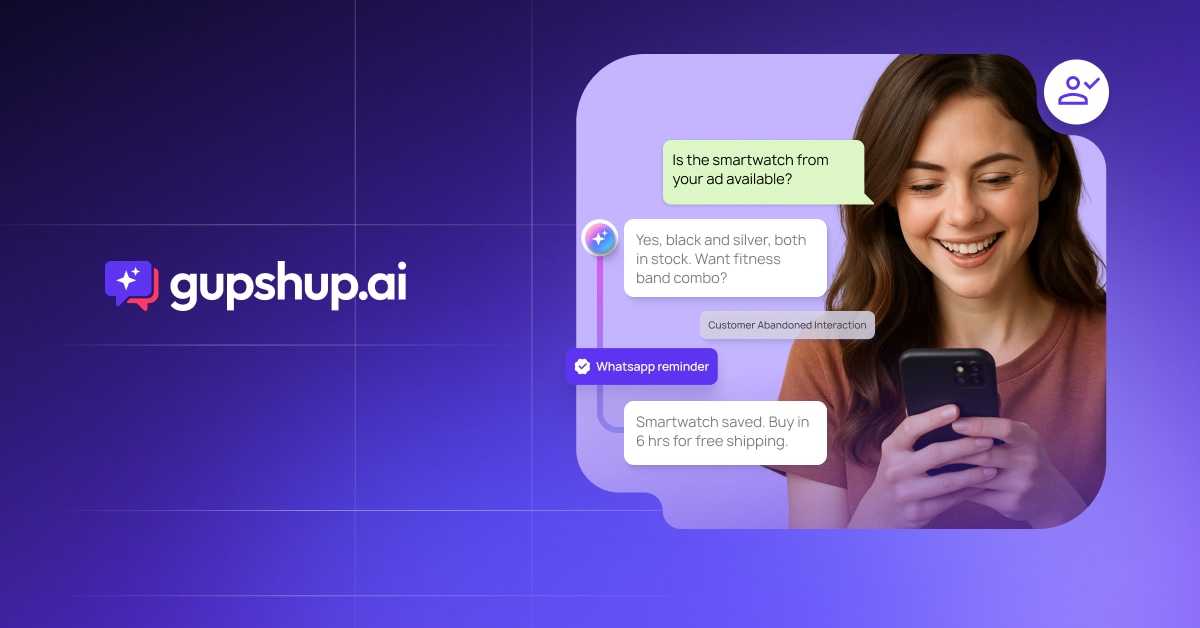
- Introduction
- Understanding the Full Drop-Off Journey: It’s Not Just Checkout
- What does this mean for marketers?
- Meet the AI Agents Powering Growth
- Why Gupshup AI Agents Are Purpose-Built for E-Commerce
- Conclusion: From Abandonment to Acceleration
- FAQs
See the power of intelligent conversations for your brand.
Introduction
The drop-off dilemma in digital retail.
What’s the real reason online shoppers abandon their carts? Hint: It’s not because they lose interest. It’s because your brand missed the moment to answer their questions, and they took their business elsewhere.
Every online purchase is built on small decisions: Is this the right fit? Will it arrive in time? What if I need to return it? The moment one of these questions goes unanswered, the sale is at risk.
We often talk about cart abandonment like it’s the core problem. But the truth is that abandonment is just the symptom. The real problem lies in the absence of intelligent, real-time, contextual conversations across the entire journey.
According to the Baymard Institute, the global cart abandonment rate sits at 70%. This is even more pronounced during festive periods or flash sales when customer intent is high, but decision friction is higher.
At the same time, only 42% of top e-commerce sites use intelligent product recommendations. That’s a major gap because most shoppers aren’t searching for exact SKUs; they’re looking for help deciding what fits, what works, and what feels right.
This isn’t a marketing problem. It’s not a tech stack problem. It’s a broken conversation problem. And it’s exactly what Gupshup’s Conversational AI Agents are built to solve, whether as an AI agent for shopping assistants, AI agents in ecommerce, or Conversational AI Agents for ecommerce use cases across markets.
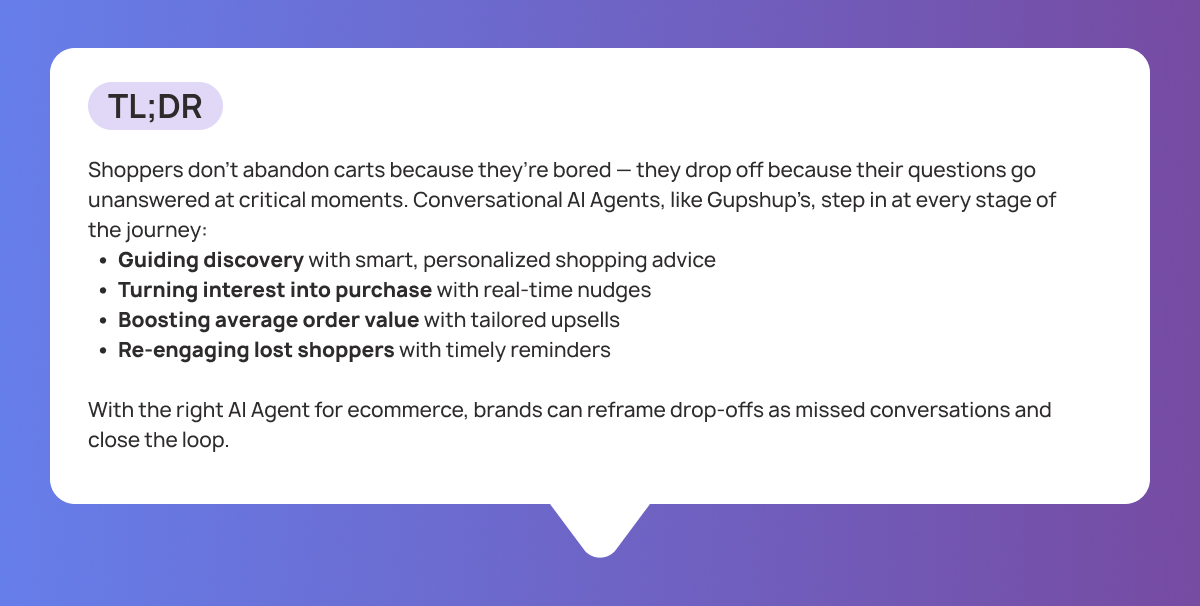
Understanding the Full Drop-Off Journey: It’s Not Just Checkout
Let’s be real: Most shoppers abandon their carts because they get stuck at key decision points. The product’s not quite right. The checkout is a mess. Or worse, they can’t get answers to basic questions. In fact, 74% of consumers abandoned their shopping baskets due to feeling overwhelmed by content, too many choices, or the effort required to make a decision.
Here’s how those friction points break down across the shopper journey.
Discovery: When interest meets information overload
This is the moment of curiosity. A shopper clicks on an ad or arrives via search with intent but is immediately bombarded with hundreds of options, filters that barely help, and product descriptions that leave more questions than answers. An AI Agent in shopping is the solution here.
- Friction 1: Choice paralysis
Too many SKUs with too little context. Shoppers are lost in a sea of options. They’re asking questions like: ‘Is this cotton or polyester?’ or ‘Do I need to buy hooks separately?’—small doubts that can kill the buying mood.” - Friction 2: Missing personalization logic
Most platforms rely on static filters, not intelligent guidance. There’s no nudging toward bestsellers, what’s back in stock, or what’s compatible with previous purchases. That’s an opportunity gap. - Friction 3: Price-conscious behaviour
Shoppers open parallel tabs to compare prices. If you’re not offering perceived value (“Is this available for cheaper elsewhere?”), you risk becoming a research stop, not the point of conversion. - Friction 4: Intent mismatch
The product may be right, but not in the format they need. “Does this include batteries?” “Will I need an additional cable?” These aren’t afterthoughts, they’re drop-off triggers.
Consideration: Where doubt enters the conversation
This is where shoppers start weighing options, building trust, or abandoning the journey entirely. A smart AI agent for a shopping assistant helps close gaps at this stage.
- Friction 5: Delayed answers, delayed decisions
Traditional FAQ pages leave customers hanging with questions like: ‘Will this AC tonnage work for my 500 sq ft living room?’ or ‘What’s the return process if this doesn’t fit?’—creating frustration and uncertainty that can send them straight to a competitor. If customers can’t get real-time, context-aware support, they’ll pause and maybe never come back. - Friction 6: Inflexible policies, unclear delivery timelines
Even a great product becomes irrelevant if the delivery promise is vague (“Will it reach before my friend’s birthday?”). Today’s shoppers don’t just want next-day delivery, they want next-moment certainty. - Friction 7: Lack of assistive selling
Shoppers often struggle to choose between two similar products. The absence of smart comparisons (e.g., “Show me the key difference in battery life or warranty coverage”) leads to decision fatigue. - Friction 8: No virtual-to-physical bridge
High-involvement categories like jewelry, home décor, and mattresses demand physical validation. When digital journeys don’t offer try-at-home or store-locator flows, the path simply ends.
Purchase: The moment that should be simple, but isn’t
Just because the cart is full doesn’t mean the decision is final. This is often where things fall apart. That’s why AI agents for ecommerce is trained to reduce cart friction, suggesting payment options, clarifying delivery timelines, and nudging action at the right moment.
- Friction 9: Checkout complexity
Multiple form fields, coupon code confusion, unclear shipping costs—shoppers get frustrated fast. A well-intentioned buyer can abandon the cart simply because they couldn’t find the CVV code. - Friction 10: Cognitive overload meets external distraction
A phone rings. The baby cries. Another tab wins attention. Shoppers rarely abandon because of disinterest; it’s often a fragile moment interrupted. Brands don’t plan for these micro drop-offs. - Friction 11: Payment-related anxiety
No clear breakdown of charges? No clarity on EMI or COD? A small payment-related doubt creates a big enough reason to bounce.
Post-Purchase: Where loyalty (or regret) is cemented
Post-purchase is often treated as an operational backend. In reality, it’s where long-term value is either built or broken.
- Friction 12: Lack of proactive communication
After checkout, the silence begins. Shoppers are left wondering: ‘When’s my package arriving?’ or ‘Can I change my delivery address?’ Without updates or easy access to support, trust slips away—and so does their loyalty.
- Friction 13: Returns are unclear or inconvenient
Customers want clarity upfront: “Do I get a refund or store credit?” “Can I schedule a pick-up?” If return journeys aren’t as smooth as the purchase path, you won’t get another shot. - Friction 14: Missed moment of advocacy
The moment the product arrives and a shopper is happy is your best chance to nudge a review, a referral, or a repeat. Most brands miss this completely
What does this mean for marketers?
Each of these triggers is a missed sale and a missed conversation. In reality, shoppers aren’t dropping off because they lost interest. They’re dropping off because you didn’t stay in the conversation long enough to guide them through their hesitation.
The answer isn’t just a better website. It’s Conversational AI Agents that listen, understand, and assist in the moment. Which is where AI Agents come in.
Meet the AI Agents Powering Growth
Traditional automation stops at scripted flows. Gupshup’s AI Agents merge user signals, business logic, and contextual nudges to move shoppers from friction to fulfillment.
Below is a closer look at how these AI agents operate behind the scenes to solve core business problems and how they show up in real conversations.
Product Finder AI Agent
Strategic role:
Replaces static product pages with guided, consultative interactions. Helps shoppers make faster, more confident decisions in cluttered digital environments.
Business impact:
- Lifts product discovery-to-add-to-cart rate
- Reduces time spent per decision, especially for new users
- Increases basket size through intelligent product bundling
Key capabilities:
- Dynamic product filters based on preferences
- Instant comparisons between similar SKUs (specs, pricing, delivery)
- Contextual suggestions (e.g., accessories, bundles)
- Multilingual catalog support
- Checkout-ready nudges tied to inventory, demand, and urgency
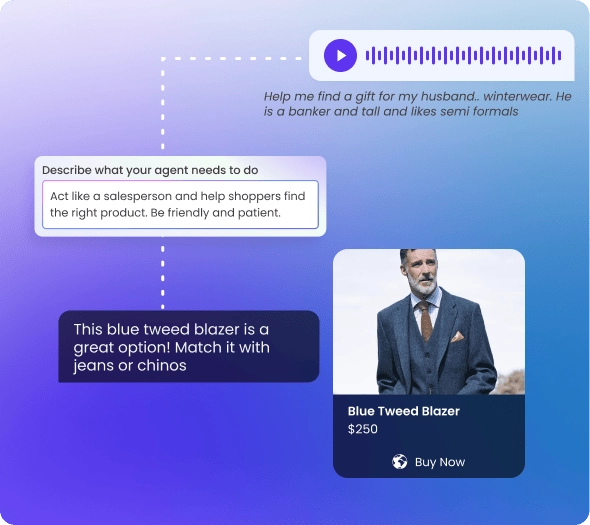
Why it matters:
Most product drop-offs happen before intent solidifies. This AI Agent bridges the gap between curiosity and conversion with consultative logic tailored to each customer’s path.
Lead Capture & Nurture AI Agent
Strategic role:
Turns offline reach and digital discovery into enriched, high-intent leads. Designed to bridge media investments with measurable outcomes.
Business impact:
- Improves conversion rates from paid media (QR, TV, DOOH)
- Reduces lead leakage across fragmented entry points
- Builds segmented, ownable customer databases
Key capabilities:
- Lead capture from offline (TV, QR, print) and online (ads, social) touchpoints
- Qualification via conversational flows (preferences, budget, intent)
- Auto-tagging and CRM sync with behavioural metadata
- Ongoing nudges for restocks, launches, and limited-period offers
- A/B-tested nurture tracks based on product category or urgency
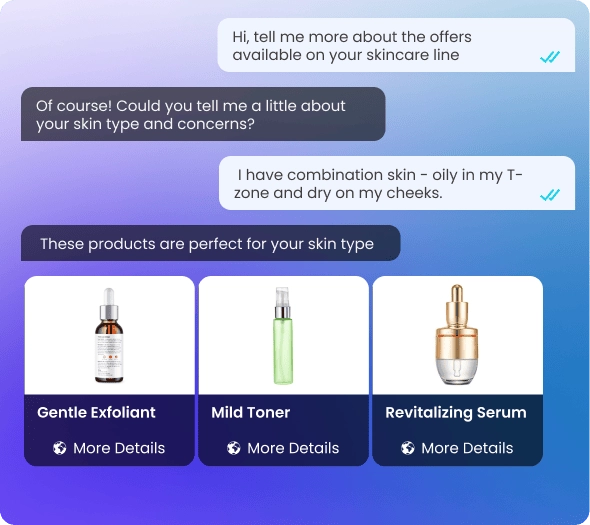
Why it matters:
Capturing a lead is only half the job. This Agent ensures timely, contextual follow-ups that feel personal, not pushy, while reducing dependence on manual retargeting.
Order Management AI Agent
Strategic role:
Creates a post-purchase experience that’s responsive, self-serve, and confidence-building. Designed to reduce churn, customer service load, and RTOs.
Business impact:
- Cuts WISMO (Where is My Order?) queries by 70–90%
- Increases repeat purchase likelihood by resolving issues fast
- Reduces operational cost per ticket and lowers agent handoff volume
Key capabilities:
- Order tracking, live ETAs, and proactive delay notifications
- Returns, exchanges, and cancellations with real-time logic
- Refund flow orchestration (via Stripe, Razorpay, etc.)
- Post-purchase product/policy queries
- Issue tagging and routing for complex queries
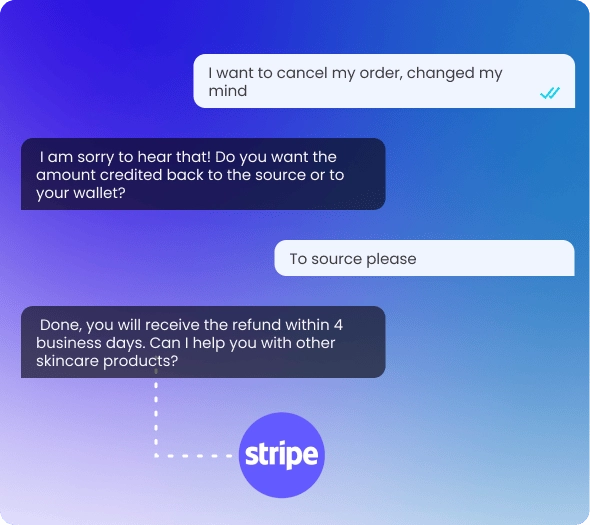
Why it matters:
Poor post-purchase experience is one of the biggest contributors to customer churn. This Agent helps brands win trust where it’s easiest to lose after money has changed hands.
Warranty Sales AI Agent
Strategic role:
Activates high-margin post-sale monetization through personalized upselling. Designed to convert dormant ownership moments into revenue.
Business impact:
- Boosts warranty attachment rate through timely nudges
- Automates service reminders and AMC renewals
- Drives upsell revenue with zero dependence on outbound agents
Key capabilities:
- Identifies eligible users via purchase history and product category
- Sends timely prompts for warranty extensions or upgrades
- Cross-sells maintenance plans, accessories, or damage protection
- Handles digital registration and document sharing (PDF, invoice, confirmation)
- Multichannel outreach (WhatsApp, SMS, RCS)
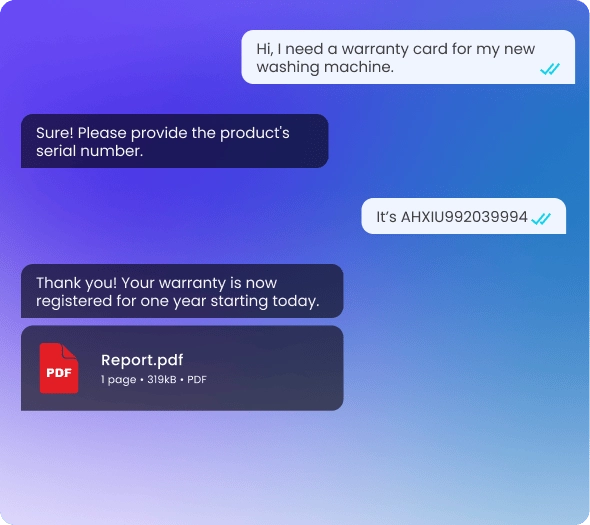
Why it matters:
Brands spend heavily to acquire a customer, but often underinvest in post-sale monetization. This Agent unlocks long-tail value without increasing CAC.
Why Gupshup AI Agents Are Purpose-Built for E-Commerce
Gupshup’s AI Agent platform is engineered for speed, scale, and real-world business outcomes. Unlike generic automation tools, it’s built for commerce-grade complexity, without compromising usability.
What sets it apart:
- Low-code and business-user friendly: Launch new journeys, test offers, and iterate campaigns without developer dependency.
- Pre-built Agent Library: Choose from a catalog of ready-to-deploy agents trained on use cases like product discovery, lead nurturing, order management, and post-sale upselling.
- Multimodal and multilingual: Engage users across WhatsApp, web chat, voice, SMS, or even Instagram DMs—using their preferred language and channel.
- Plug-and-play integrations: Works with your CRM, payment gateways, ticketing tools, and logistics stack.
Goal-based orchestration: Agents are trained to drive specific outcomes, conversion, retention, and AOV, not just respond to queries.
Conclusion: From Abandonment to Acceleration
Drop-offs are a missed opportunity to engage, assist, and convert. Every hesitation in the shopper journey is a silent request for clarity, confidence, or convenience. Brands that treat these moments as data points lose customers. Brands that treat them as conversations win loyalty.
This shift demands real-time, decision-aware systems that act with precision. That’s the difference Gupshup’s Conversational AI Agents bring to e-commerce. They don’t just respond, they anticipate. They’re built to unlock intent, simplify decisions, and accelerate outcomes.
Whether it’s guiding a customer through a cluttered catalog, reviving interest after a dropped chat, resolving delivery concerns before they escalate, or unlocking post-sale value with timely offers, every AI Agent is engineered to move the needle on your most important KPIs.
In a market where attention is short, stakes are high, and expectations are evolving faster than funnels can adapt, scalable conversation is the new conversion engine. Gupshup gives you that engine, fully equipped, field-tested, and ready to deploy.
Want to deploy AI agents for your brand? Book a personalized demo today
FAQs
1. How does AI affect online shopping?
AI improves online shopping by making it faster, smarter, and more personalized. It helps customers find the right products, answers questions instantly, and removes friction at checkout, all leading to higher conversions and a better overall shopping experience.
2. How are AI Agents transforming customer engagement across industries?
AI Agents enable businesses to offer real-time, personalized support at scale. Whether helping shoppers online, assisting patients with scheduling, or guiding users through a service process, these agents simplify complex journeys and keep customers engaged across channels and industries.
3. What is the impact of Conversational AI?
Conversational AI reduces response time, improves customer satisfaction, and increases efficiency. By handling common queries, guiding users, and offering instant support, it helps businesses deliver seamless, 24/7 service while freeing up human teams for more complex tasks.
4. What is an example of Conversational AI?
Siri, Alexa, and Google Assistant are some examples of Conversational AI. A chatbot on an e-commerce site that helps users compare products, answers queries is also an example of conversational AI in action. It combines automation with conversation to create a more helpful shopping experience.



 +91-9355000192
+91-9355000192 Login
Login





